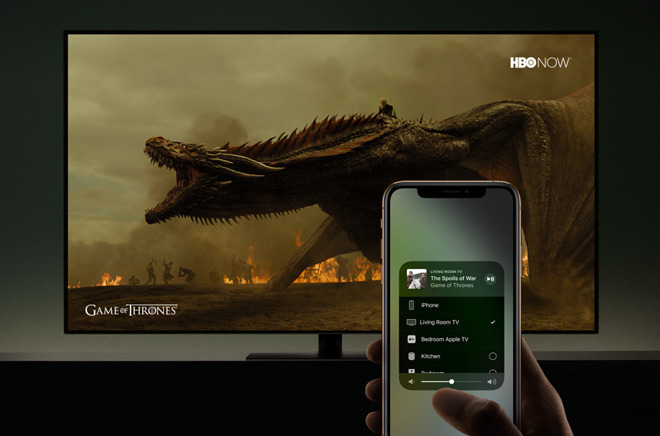HomeKit and AirPlay 2 will unlock a host of new functionality thanks to integration into many leading manufacturer's television sets, including Samsung, Vizio, and LG. AppleInsider examines what that will look like, and what you'll be able to do, when the features are available.

Arguably the biggest news out of CES 2019 was Apple's surprise embrace of the TV industry with four major manufacturers announcing the integration of key Apple features into their sets. LG, Vizio, Sony, and Samsung all announced support for AirPlay 2 and Siri on some recent TVs while all but the last introducing support for HomeKit.
Immediately after the news emerged, social media was rife with potential customers evaluating the purchase of a new model -- even before solid information was available about what HomeKit can and can't do. So, while we await software updates, and the release of the promised new models, let's talk about it.
A new category is introduced
TVs are now an entirely new category in HomeKit, which means they don't show as solely as a simple speaker or Apple TV. They have their own properties and characteristics exposed to HomeKit.
Speakers, for instance, you can just turn up/down as well as play/pause. Alternatively, TVs have many more options within HomeKit.
To start, you can turn your set on or off or adjust the volume all the means you interface with HomeKit now, including Siri. Changing the input, controlling the brightness, and setting the picture mode or media state is all possible through HomeKit as well. This opens up so much more, especially if can be integrated into scenes.
Taking things even further, normal remote functions can be carried out through HomeKit with key simulation. So if there is something the TV needs to do unique, it is possible to expose those keys for use, negating the need to ever grab the manufacturer's remote ever again.
This is possible with the Apple TV now -- to some extent. There is limited HDMI-CEC information transmittal back to a television through the HDMI cable to a compatible television, but the implementation is spotty.
Integration into scenes
Speakers, as mentioned, really only can have their volume and media state controlled through HomeKit. They can't be integrated into scenes like other accessories. This is very limiting to users and high on our wish list for June.
TVs, on the other hand, have many more properties that could make more sense in scenes -- but, as of yet, specific information on what can be done is limited, and vendors at CES itself weren't talking about it.
But for now, your bedtime scene now doesn't just turn off the lights, lock the doors, close the garage, shut the blinds, and turn down the temperature. It should be able to do all that plus shut off your TV without relying on a HomeKit socket.
Maybe a "movie time" scene will be able to dim the lights and turn on the TV. A "Night mode" scene may be able to turn on the TV and turn the volume to a less wall-shaking decibel out of respect for others. "Game time" could turn on the TV, set a cool color backlight with the Hue Play, turn up the volume, and switch the input to your PS4.
Inevitable limitations
Naturally, there are going to be limitations here on what you can do. The biggest is that this won't act as an Apple TV replacement. Samsung's implementation isn't getting HomeKit -- but is getting the iTunes movies and TV store. Also, the Vizio and LG versions don't have iTunes, and are limited to just AirPlay 2 and HomeKit. The full tvOS experience and all that entails still remains exclusive to the Apple TV.
The new TVs also won't act as a Home Hub. You still need an Apple TV, a plugged-in iPad, or a HomePod for this. Having a Home Hub gives external secure access to any HomeKit accessories like lights or locks.
Start playing
These new TVs and updates will be available soon in a variety of sizes and price points. If you're in the market, these would be excellent to consider, whether or not you already have an Apple TV. And, it's worthwhile to see what can be found refurbished from Vizio, given that the company will roll out support for some supporting models back to 2016.
Apple has compiled a list on its website to see which models may be getting the update and which new ones are on the way.

